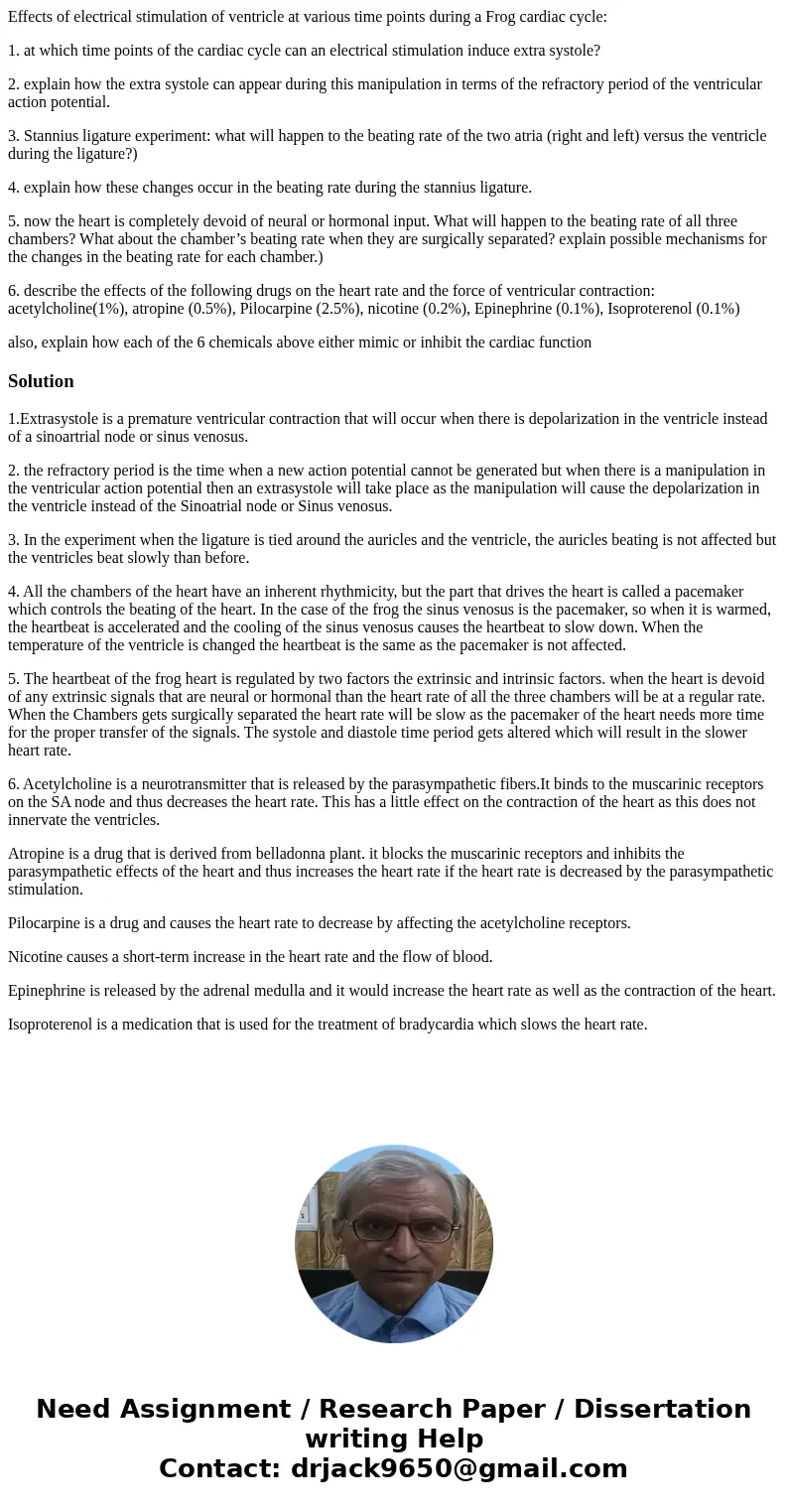Effects of electrical stimulation of ventricle at various ti
Effects of electrical stimulation of ventricle at various time points during a Frog cardiac cycle:
1. at which time points of the cardiac cycle can an electrical stimulation induce extra systole?
2. explain how the extra systole can appear during this manipulation in terms of the refractory period of the ventricular action potential.
3. Stannius ligature experiment: what will happen to the beating rate of the two atria (right and left) versus the ventricle during the ligature?)
4. explain how these changes occur in the beating rate during the stannius ligature.
5. now the heart is completely devoid of neural or hormonal input. What will happen to the beating rate of all three chambers? What about the chamber’s beating rate when they are surgically separated? explain possible mechanisms for the changes in the beating rate for each chamber.)
6. describe the effects of the following drugs on the heart rate and the force of ventricular contraction:
acetylcholine(1%), atropine (0.5%), Pilocarpine (2.5%), nicotine (0.2%), Epinephrine (0.1%), Isoproterenol (0.1%)
also, explain how each of the 6 chemicals above either mimic or inhibit the cardiac function
Solution
1.Extrasystole is a premature ventricular contraction that will occur when there is depolarization in the ventricle instead of a sinoartrial node or sinus venosus.
2. the refractory period is the time when a new action potential cannot be generated but when there is a manipulation in the ventricular action potential then an extrasystole will take place as the manipulation will cause the depolarization in the ventricle instead of the Sinoatrial node or Sinus venosus.
3. In the experiment when the ligature is tied around the auricles and the ventricle, the auricles beating is not affected but the ventricles beat slowly than before.
4. All the chambers of the heart have an inherent rhythmicity, but the part that drives the heart is called a pacemaker which controls the beating of the heart. In the case of the frog the sinus venosus is the pacemaker, so when it is warmed, the heartbeat is accelerated and the cooling of the sinus venosus causes the heartbeat to slow down. When the temperature of the ventricle is changed the heartbeat is the same as the pacemaker is not affected.
5. The heartbeat of the frog heart is regulated by two factors the extrinsic and intrinsic factors. when the heart is devoid of any extrinsic signals that are neural or hormonal than the heart rate of all the three chambers will be at a regular rate. When the Chambers gets surgically separated the heart rate will be slow as the pacemaker of the heart needs more time for the proper transfer of the signals. The systole and diastole time period gets altered which will result in the slower heart rate.
6. Acetylcholine is a neurotransmitter that is released by the parasympathetic fibers.It binds to the muscarinic receptors on the SA node and thus decreases the heart rate. This has a little effect on the contraction of the heart as this does not innervate the ventricles.
Atropine is a drug that is derived from belladonna plant. it blocks the muscarinic receptors and inhibits the parasympathetic effects of the heart and thus increases the heart rate if the heart rate is decreased by the parasympathetic stimulation.
Pilocarpine is a drug and causes the heart rate to decrease by affecting the acetylcholine receptors.
Nicotine causes a short-term increase in the heart rate and the flow of blood.
Epinephrine is released by the adrenal medulla and it would increase the heart rate as well as the contraction of the heart.
Isoproterenol is a medication that is used for the treatment of bradycardia which slows the heart rate.

 Homework Sourse
Homework Sourse